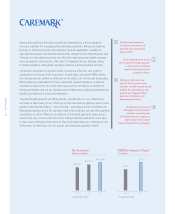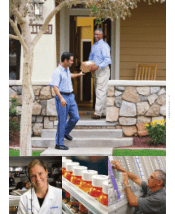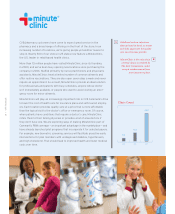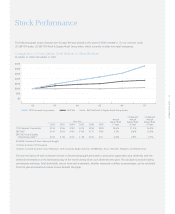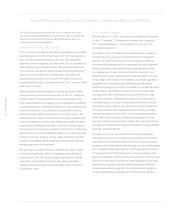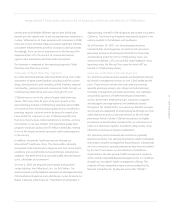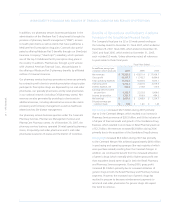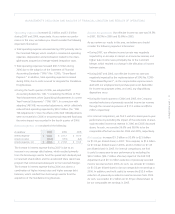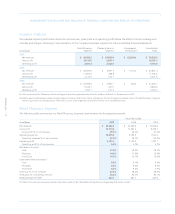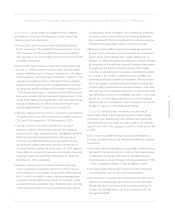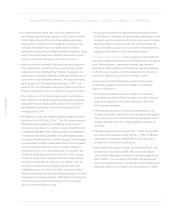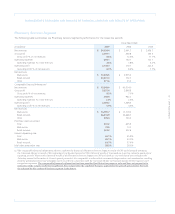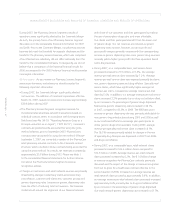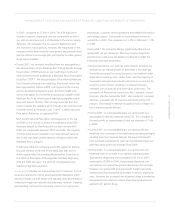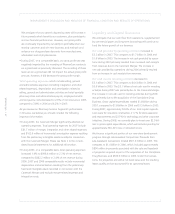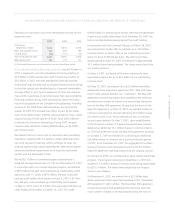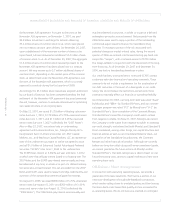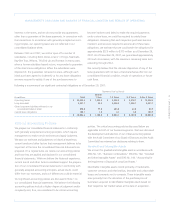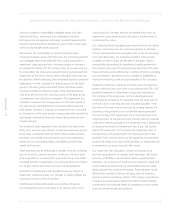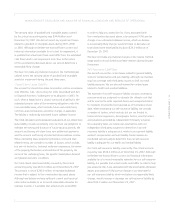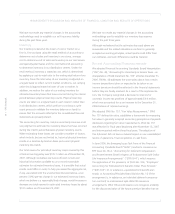CVS 2007 Annual Report Download - page 28
Download and view the complete annual report
Please find page 28 of the 2007 CVS annual report below. You can navigate through the pages in the report by either clicking on the pages listed below, or by using the keyword search tool below to find specific information within the annual report.
24 I CVS Caremark
• Our pharmacy gross profit rates have been adversely affected
by the efforts of managed care organizations, pharmacy benefit
managers, governmental and other third party payors to reduce
their prescription costs. In the event this trend continues, we
may not be able to sustain our current rate of revenue growth
and gross profit dollars could be adversely impacted.
Total operating expenses, which include store and administra-
tive payroll, employee benefits, store and administrative occupancy
costs, selling expenses, advertising expenses, administrative
expenses and depreciation and amortization expense increased
to 23.1% of net revenues in 2007, compared to 22.7% of net
revenues in 2006 and 22.2% of net revenues in 2005.
As you review our Retail Pharmacy Segment’s performance
in this area, we believe you should consider the following
important information:
• Total operating expenses as a percentage of net revenues
continued to be impacted by an increase in the sale of generic
drugs, which typically have a lower selling price than their
brand named equivalents.
• Total operating expenses increased as a percentage of net
revenues during 2007 and 2006, due to increased store payroll
costs, primarily driven by the Standalone Drug business, which
operates at higher costs due to the geographic locations of
the stores.
• Total operating expenses increased $60.7 million during 2006
as a result of the adoption of the SFAS No. 123(R). In addition,
total operating expenses increased due to costs incurred to
integrate the Standalone Drug Business.
• During the fourth quarter of 2006, we adopted SAB No. 108.
In connection with adopting SAB 108, we recorded adjust-
ments, which collectively reduced total operating expenses by
$40.2 million. Since the effects of the SAB 108 Adjustments
were not material to 2006 or any previously reported fiscal year,
the entire impact was recorded in the fourth quarter of 2006.
• Our pharmacy gross profit rate continued to benefit from
an increase in generic drug revenues in 2007, which normally
yield a higher gross profit rate than equivalent brand name
drug revenues. However, the increased use of generic drugs
increased the pressure from third party payors to reduce
reimbursement payments to retail pharmacies for generic drugs,
which reduced the benefit we realized from brand to generic
product conversions. We expect this trend to continue.
• Sales to customers covered by third party insurance programs
have continued to increase and, thus, have become a larger
component of our total pharmacy business. On average, our
gross profit on third party pharmacy revenues is lower than our
gross profit on cash pharmacy revenues. Third party pharmacy
revenues were 95.3% of pharmacy revenues in 2007, com-
pared to 94.7% of pharmacy revenues in 2006 and 94.1% of
pharmacy revenues in 2005. We expect this trend to continue.
• The introduction of the Federal Government’s new Medicare
Part D benefit is increasing utilization, but decreasing pharmacy
gross profit rates as higher profit business (such as cash and
state Medicaid customers) continued to migrate to Part D
coverage during 2007.
• On February 8, 2006, the President signed into law the Deficit
Reduction Act of 2005 (the “DRA”). The DRA seeks to reduce
federal spending by altering the Medicaid reimbursement
formula for multi-source (i.e., generic) drugs. According to the
Congressional Budget Office, retail pharmacies are expected
to negotiate with individual states for higher dispensing fees
to mitigate the adverse effect of these changes. These changes
were scheduled to begin to take effect during the first quarter
of 2007 and were expected to result in reduced Medicaid
reimbursement rates for retail pharmacies. During 2007, the
Centers for Medicare and Medicaid Services (“CMS”) issued
a final rule purporting to implement the new reimbursement
formula. On December 14, 2007, the U.S. District Court for
the District of Columbia preliminarily enjoined CMS from
implementing the new rule to the extent such action affects
Medicaid reimbursement rates for retail pharmacies. As a result,
implementation has been delayed indefinitely. Accordingly, the
extent of any reductions and the impact on the Company
cannot be determined at this time.


